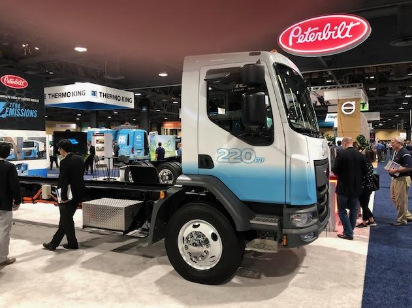Electric trucks took up a lot of space in the exhibit hall at this year’s ACT Expo — and that meant  medium and heavy trucks along with commercial applications such as electric delivery and refuse trucks. This time major truckmakers took center stage, and specialized makers had announcements to share as well. With about 4,000 attendees, it was the largest ACT Expo yet.
medium and heavy trucks along with commercial applications such as electric delivery and refuse trucks. This time major truckmakers took center stage, and specialized makers had announcements to share as well. With about 4,000 attendees, it was the largest ACT Expo yet.
During his keynote speech, Roger Nielsen, president and CEO of Daimler Trucks North America (DTNA), the largest commercial vehicle manufacturer in North America, said his company will be putting about 50 battery electric test vehicles on roads by the end of this year through its Freightliner division, built at a renovated plant in Oregon. 20 of them will be medium- and heavy-duty electric trucks for Penske Corp. and NFI Inc., a major third-party logistics company, under a grant from the South Coast Air Quality Management District. Near-zero-emissions natural gas medium- and heavy-duty vehicles are currently available and will continue from Freightliner as an interim solution until full commercialization of the battery-electric Freightliner eM2 and eCascadia, he said. Its Thomas Built unit will be rolling out Proterra-powered electric school buses.
Peterbilt Motors Co. showed off new electric trucks, including the Model 220EV, Model 520EV, and Model 579EV. The 220EV is spec’d with the Meritor Blue Horizon eAxle and the 520EV will feature the Transpower mid-ship powertrain configuration, while the 579EV will feature the new Allison AXE Series e-Axle. Six of the 579EVs were demonstrated at the exhibit that have been finished for customers. “Today, we have 14 electric vehicles built, on our way to more than 30 by the end of the year, for real customer routes and to analyze performance so that our production options meet the standards customers expect when buying a Peterbilt,” said Peterbilt’s Chief Engineer Scott Newhouse.
While it was outside ACT Expo, Ford on Wednesday announced it’s putting $500 million into electric truck startup Rivian Automotive. Both companies have agreed to work together to develop a battery electric vehicle for Ford’s growing EV portfolio using Rivian’s skateboard platform.
Volvo Trucks North America Wednesday hosted the California Air Resources Board (CARB) as they presented a $44.8 million check to the South Coast Air Quality Management District (South Coast AQMD) for the Volvo LIGHTS (Low Impact Green Heavy Transport Solutions) project. The Volvo LIGHTS project is a partnership among the Volvo Group, South Coast AQMD and industry leaders in transportation and electrical charging infrastructure. The project was created ti demonstrate the ability of battery electric vehicles to improve freight and warehouse efficiencies, reduce emissions, and improve air quality. As part of the project, Volvo Trucks will introduce all-electric Volvo VNR regional-haul demonstrators in California later this year, with vehicle sales planned to begin in 2020.
Other introductions at ACT Expo 2019 included:
- BYD Motors will deliver 14 yard tractors to two BNSF Railway intermodal facilities in Southern California, adding to an ongoing demonstration project.
- Chanje has partnered with refrigeration unit supplier Thermo King on a prototype zero-emissions refrigerated van.
- Xos, the new name for electric truck startup Thor Trucks, will retrofit two Loomis Armored US cash-hauling trucks. An order for 100 more trucks awaits if the test models show the trucks’ value.
- EV Connect is launching a program aimed at standardizing EV charger management and use for both transportation fleets and charging-equipment developers. The EV Charge Station Certification program already has been completed by seven of the industry’s largest charger makers.
- Ryder’s booth featured a comprehensive charging infrastructure solution, provided by In-Charge Energy. In-Charge provides nationwide turnkey energy and commercial electric vehicle infrastructure solutions to ensure customers maximize the full economic benefits of adopting electric vehicles into their fleet. Its end-to-end model focusing on behind the meter solutions is an industry first.
- An Amply Power Inc. white paper showed fleets saved an average 37 percent compared with traditional fuels by electrifying their buses and light-duty vehicles. Fleets that charged during off-peak hours could save as much as 60 percent, according to the white paper.
- Tritium created the “world’s most powerful charger,” the Veefil-PK 175-475kW DC High Power Charger which can add nearly 300 miles range to an EV in just 10 minutes.
- The first production fuel cell-powered heavy-duty truck jointly developed by Toyota and Kenworth Truck Co. is going forward. The new truck is the first of 10 planned under a $41 million California Air Resources Board grant matched by Toyota, Kenworth, and Royal Dutch Shell.
- Penske Truck Leasing announced it will open commercial heavy-duty electric vehicle charging stations with 14 high-speed chargers at four of its existing facilities in Southern California. These will be among the first DC fast charging stations in the U.S. designed specifically for heavy-duty commercial electric vehicles.
- The North American Council for Freight Efficiency recently released a report, Regional Haul: An Opportunity for Trucking, that looks at this growing market segment and was shared during a seminar at ACT Expo. Long-haul trucking isn’t what it used to be, according to the report. Forty five percent of the Class 8 tractors produced today are day cabs and a high percentage of those trucks are involved in regional haul operations.
- Gladstein, Neandross and Associates (GNA) and the University of California at Riverside’s Bourns College of Engineering – Center for Environmental Research and Technology (CE-CERT) announced the launch of the Low and Zero Emission Readiness (LAZER) Initiative. This new collaboration will support organizations —including transit agencies, refuse operations, trucking carriers, delivery fleets, school districts, municipalities, and more — in evaluating the real-world economic and environmental benefits of advanced transportation technologies.



